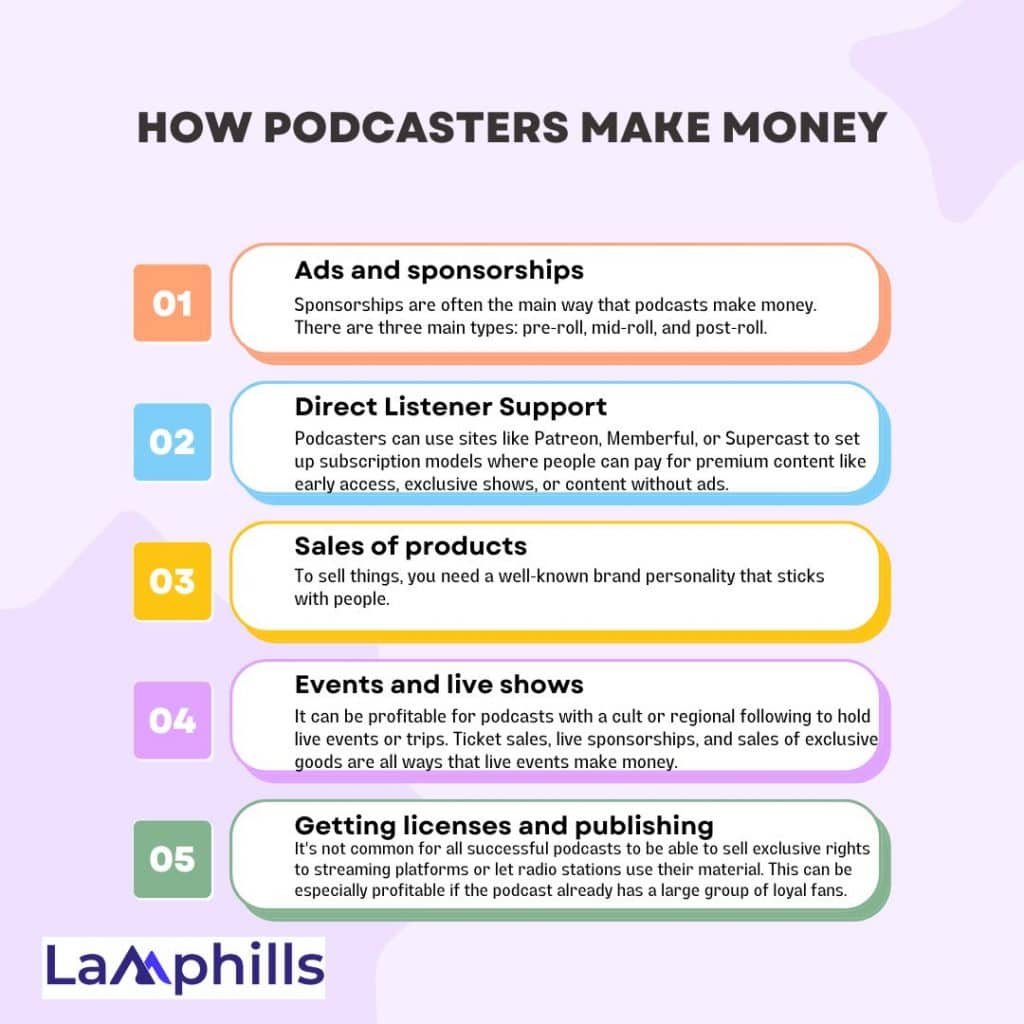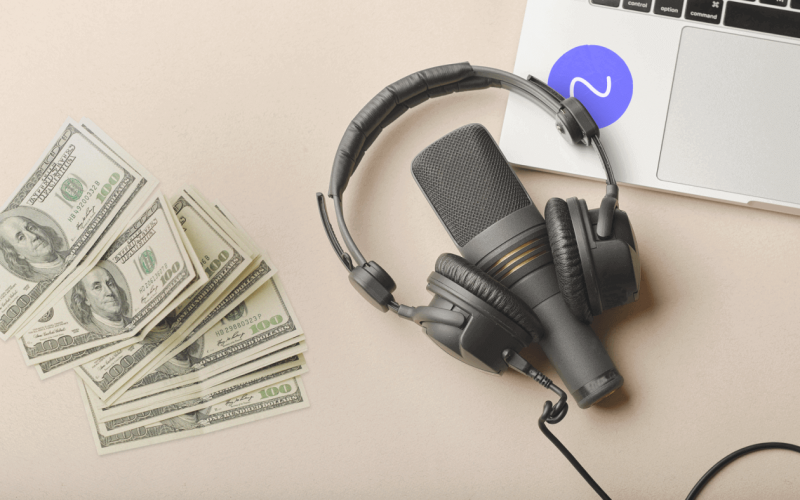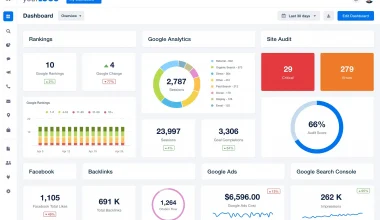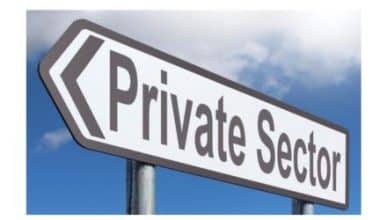With my earbuds in, I listen to my favorite show while I drink my coffee in the morning. I look forward to it every morning because of the interesting ideas and stories they share and because I’m interested in the business side of podcasts. How do these voices, which you know but haven’t seen, turn their love into money? According to a new study from Inside Radio, the podcasting business will make more than $1 billion by the end of 2024. There is money out there, but to get a piece of it, you need to plan ahead and find different ways to make money.
This piece goes deeper than the surface of how advertising can make you money. We will talk about some methods that podcasters make money that isn’t talked about as much and that can help you turn your podcast into a long-term business. This will allow you to build a loyal audience and make money doing what you love.
Key Takeaways
- The podcasting business is projected to make over $1 billion by the end of 2024, offering significant revenue opportunities for podcasters.
- Ads and sponsorships are a primary revenue source for podcasters, with different ad types like pre-roll, mid-roll, and post-roll contributing to their earnings.
- Direct listener support through platforms like Patreon allows podcasters to earn money by offering premium content and subscription models.
- Selling branded merchandise and hosting live events are effective strategies for podcasters to monetize their content and engage their audience.
- Licensing and publishing rights to streaming platforms can be a lucrative option for successful podcasts with a large and loyal following.
How Do Podcasters Make Money?

Podcasting is more than just broadcasting information; it’s a way to make money in many ways.
When it comes to how much podcasters make, the range is big. Podcasters can make anywhere from $700 to $13,000 or even a couple of million dollars a month, depending on things like how many downloads they get and how they choose to make money. As an example, a podcaster whose episodes get 10,000 downloads might make $500 to $900 a month on average. Understanding how to make a steady income is important for podcasters who want to do well in the ever-changing world of podcast marketing.
For some background, here are some podcast earning numbers:
- There are 464.7 million podcast fans in the world.
- The market for podcasts grew to a huge $18.52 billion in 2022.
- It is expected that by 2030, the podcasting business will bring in $130.63 billion.
- North America has more than 39.1% of the total income share in the podcasting market, making it the biggest market.
- It is expected that podcast ads will bring in more than $4 billion by 2024.
- Putting an ad in a radio slot costs around $50.
- For a single 30-second ad, podcasters can make at least $180 per show.
- 69% of podcasters who have been making their show for more than two years can make money from it.
In terms of money, this is how it looks:
#1. Ads and sponsorships
Sponsorships are often the main way that podcasts make money. There are three main types: pre-roll, mid-roll, and post-roll. Pre-roll plays before the podcast starts, mid-roll plays in the middle of the podcast, and post-roll plays at the end. In general, this is how it works:
- CPM Rates (Cost Per Mille): The usual CPM rates for podcast ads are about $18 for pre-roll, $25 for mid-roll, and $10 for post-roll for every 1,000 downloads. In other words, a podcast with 20,000 downloads per episode might be able to make $500 from a single mid-roll ad.
- Talking about higher prices: Podcasters whose audiences are very interested or who work in niches that make money, like finance or technology, can usually get better CPM rates. Showing a high rate of listener involvement through metrics like listener duration, social media engagement, or listener feedback can help with these talks.
#2. Direct Listener Support
Podcasters can use sites like Patreon, Memberful, or Supercast to set up subscription models where people can pay for premium content like early access, exclusive shows, or content without ads. This can add up in this way:
- Different levels of membership: By offering different tiers ($5, $10, and $20 per month), you can give people with different levels of interest and financial commitment more ways to join and pay.
- Engagement Metrics: It is usually possible to tell if a podcast is engaging by how long people listen to it and how often they connect with it. Sharing these numbers can help you get more followers.
#3. Sales of products
To sell things, you need a well-known brand personality that sticks with people. For marketing to work, it needs to:
- Qualitative and Useful: Things that are well-made and match the theme or catchphrases of the show tend to sell more. For instance, a podcast about camping trips or eco-friendly water bottles might promote brand-name camping gear.
- Limited Edition Releases: Using limited edition items to make things seem scarce can help you sell them quickly and get people more interested.
#4. Events and live shows
It can be profitable for podcasts with a cult or regional following to hold live events or trips. Ticket sales, live sponsorships, and sales of exclusive goods are all ways that live events make money. To plan great events, you need to:
- The place and time: Picking the right place and time can help you get the most people to show up. For example, setting up live shows in places where a lot of people listen to the podcast.
- Interactive Elements: Live events can be more fun if they have Q&As, meet-and-greets, or opportunities for the audience to participate in real-time.
#5. Getting licenses and publishing
It’s not common for all successful podcasts to be able to sell exclusive rights to streaming platforms or let radio stations use their material. This can be especially profitable if the podcast already has a large group of loyal fans.
Making money from podcasts is a process, not a goal. Of course, making money is important, but building a loyal audience is what makes a show work. You can use the Community Engagement Template to help you do this by:
- Getting the crowd to participate: Respond to comments, hold Q&As, and ask listeners for feedback.
- Setting up a social media account: Get the word out about your show and interact with people who listen on Twitter and Instagram.
- Putting together a group forum: Make time for people to talk to each other, share their ideas, and get to know each other.
A successful community not only gets more people to listen but also makes your podcast more appealing to people who might want to sponsor or work with it. They see how loyal your audience is and how much value you can add to their brand.
Read Also: Building Bridges with International PR (My Journey to Global Brand Storytelling)
At Lamphills, we know the unique problems and chances that podcasters face these days. We can help you start, grow, and make money from your show in several ways, such as:
Making a podcast involves coming up with ideas, researching your audience, and coming up with a structure.
- Recording, editing, audio mixing, and finishing are all production help services.
- Promotion and marketing: social media plan, guest booking, and reaching out to the press.
- Strategy for making money: creating a subscription model, finding sponsorship possibilities, and making merchandise.
We think every person has a story to tell and every podcast has the power to change the world. Are you ready to turn your love of blogging into a business? Allow Lamphills Media to help you reach your goals.
Some of the Podcasts That Make the Most Money
It is important to remember that we will never know for sure how much money a podcast makes because it is not open to the public. What they tell us and what we can figure out is all we know. Only the people who run the podcast know how much money it makes.
Also, podcasts have costs, just like any other business. That makes it hard to figure out the number we care about most: the profit. We don’t know how much the podcast owners pay to have their show run.
If podcast A makes $10,000 a month and spends $2,000 a month on costs and podcast B makes $12,000 a month and spends $8,000 a month on costs, then podcast A gets more money, but their finances are very different. We’d love to show you how much money the hosts REALLY take home, but we don’t have that knowledge.
So, to help you see what’s possible, here are some facts about some of the podcasters who make the most money.
- Each show of The Joe Rogan Experience brings in around $800,000. His show makes $9.6 million a month with three episodes a week. On YouTube, he makes an extra $16,500 to $264,000.
- 32,874 people visit Chapo Trap House every month, which is worth $147,262 per year.
- There are two podcasts from Pat Flynn’s Smart Passive Income. His most popular podcast doesn’t have ads, but affiliate sales bring in more than $100,000 a month.
- There are 11,290 subscribers to Last Podcast On The Left, which is $53,958 a month.
- 10,638 people visit Tiny Meat Gang every month, which is $51,199.
- With money from ads, YouTube, and Twitch, The H3 Podcast makes just under $500,000 a month.
- Podcast ads bring in more than $15 million for The Ringer.
Read Also: The Top 2024 Brand Mention Tools (All You Need)
What is the Average Money Most Podcasts Make?
People really mean “How much can the average podcaster make?” when they ask us “How much money can podcasters make?” It will be a while before you can run a popular show that has been downloaded 10 billion times. Let’s talk about some useful numbers.
First, let’s assume a few things that make sense.
- There are three ads in each episode: one before the show starts, one during the show, and one after the show ends.
- About 2% of your viewers will back you on Patreon. They give $5 a month, which is the standard amount.
- Every month, 1% of your viewers will use your affiliate link to buy something. There is a $15 commission for every sale. Every month, 0.05% of your viewers buy an online course. It costs $99 to take the lesson.
- Every month, you put out four episodes. A month has 4.3 weeks, but we’re just going with round numbers to keep things easy.
In this case, if 1,000 people download each episode, companies aren’t interested in your show yet, but you can still make money.
- $100 a month to help Patreon
- $150 a month from partner sales
- $495 a month from course sales
- $745 a month in total
Read Also: How Much Do Social Media Influencers Make? Income Breakdown
You’ll start getting sponsors if every show gets 5,000 downloads. You can charge around $20 CPM for ads.
- $1,200 a month on ads
- $500 a month to help Patreon
- $750 a month from partner sales
- $2,475 a month from course sales
- That’s $4,925 a month.
People will start to pay attention to your show if each episode gets 10,000 downloads. You can charge around $50 CPM for ads.
- $6,000 a month on ads
- $1,000 a month to help Patreon
- $1,500 a month from partner sales
- $4,950 a month from course sales = $13,450 a month
Remember that these numbers are based on the things we said above were true. The amount of money your show makes from each source may be different. You can’t start making podcasts before your online course is ready. Because your community is similar to theirs, a sponsor might offer to pay you more per click (CPM).
Important Things I Did to Get Ready for My Podcasting Journey
There are a few things you can do to make your podcast much more likely to succeed before you start exploring the exciting world of podcasts. I went about these basics in this way, with examples from my made-up podcasting journey for each:
#1. Figure out your audience and niche
When I chose to make a podcast about digital art skills, I knew I had to be very specific to reach the right people. I was able to more accurately target content by focusing on digital art for beginners. This not only helped me make more relevant episodes but also helped me get sponsors for art software and graphic tablets.
#2. Spend money on good tools
When I first started making podcasts, I quickly learned that bad sound quality turned off a lot of people. Getting a good microphone and some basic soundproofing changed the sound of my show, making it sound more professional and fun for people to listen to.
#3. Plan your content
I planned the first 20 shows before I started so I wouldn’t run out of ideas, which happens a lot. As part of this planning, I thought about doing interviews with experienced digital artists and making tutorials on popular techniques. This helped me stick to a regular posting schedule and kept the content fresh and interesting.
#4. Learn how to edit audio
After I recorded my first show, I realized I needed to edit it to get rid of pauses and background noises that weren’t needed. I put in time to learn how to use software like Audacity for simple audio editing, which helped me make episodes that sounded better and more professional.
#5. Come up with a plan for marketing
Before I released my podcast, I set up a social media account to talk to people in the digital art community and tease future episodes. This marketing before the launch built a list of people who were interested in listening and gave them a way to keep interacting with my show, which increased its visibility.
#6. Learn about SEO for podcasts
I learned about podcast SEO by adding keywords about digital art and technology to episode titles, descriptions, and show notes. This SEO approach made it easier for people to find my podcast on platforms and search engines, which brought in people who were interested in digital art topics.
#7. Make plans for attainable goals and assess
At first, I didn’t have clear goals for my show, which made it hard to tell how well it was doing. I started to set measurable goals for downloads, listener engagement, and possible revenue. I also started to look back at my performance every month to see what tactics were working and what needed to be changed.
These steps helped me build a strong base for my show, which not only improved the quality of the content but also made sure it reached and spoke to the right people.
How Many People Do You Need to Listen to Your Podcast to Make Money?
There are no hard and fast rules about when you can start making money from podcasts. It’s never too early to start making money from your show.
Some of the most successful podcasters have a big following, but smaller podcasters who are good at business can also make a lot of money.
It’s a good idea to keep building your audience if you want to make more money since bigger podcasts can usually find more ways to make money from all sources.
How Long Does It Get Pay to Make a Podcast?
Different podcasts start making money at different times. Podcasters start from scratch and have to build an audience, make sure they consistently offer high-quality content, and come up with good ways to make money. Some podcasts may start making money quickly through ads or partnerships, while others may need more time to build their audience and start making money.
In conclusion
It can be both exciting and rewarding to start a podcasting business. Podcasters have the chance to turn their hobby into a business because there are many ways to make money from it. With strategic help from companies like Lamphills and knowledge of these paths, a podcast can go from a hobby to a job.
So, are you ready to look into these chances and maybe make your podcast your major source of income?
Related Articles
- 9 Personal Branding Hacks for Insane Growth in 2024
- How To Get Speaking Engagements: Best Tips
- Top Media Outlets in 2024: A Trustworthy Guide for Authoritative News Sources
- CONTENT MARKETING: A User-Guide to Developing Your Business
- WHAT CAN YOU DO TO MAKE A HEADLINE MORE COMPELLING? Content Hacks 101






